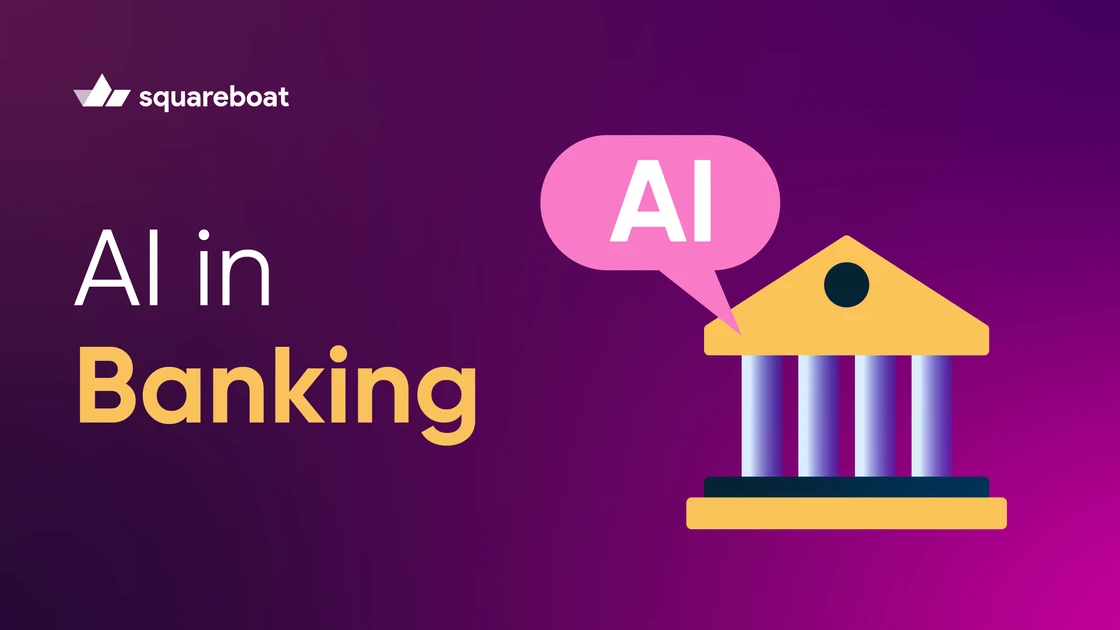AI is becoming noticeable in all of the major industries in today's rapidly evolving digital landscape. AI has improved business efficiency and raised productivity to new heights in a variety of industries, including healthcare, e-commerce, manufacturing, and transportation. The banking sector is no exception, as it quickly adopts AI to provide millions of clients worldwide with individualized services. AI is changing the banking experience with everything from automated fraud detection systems to virtual assistants that are always available to provide assistance. The cutting-edge machine learning-based tools have already been adopted by banks for credit risk assessment, enabling the risks mitigation in real-time and the creation of custom loan packages with lower risks. The increasing applications of AI are expected to enhance the security, accessibility, and personalization of financial services. Let’s look at the changes that these technologies powered by AI offer to the banking sector.
AI in Banking Explained: How It Works?
AI-powered systems leverage advanced technologies to automate repetitive tasks and enhance banking operations by imitating human cognitive functions. The incorporation of AI-based technologies improves customer service and automates banking operations, and this is achieved by implementing advanced algorithms based on machine learning to augment fraud detection, aid in real-time risk assessment, sift through large data sets, and create customized financial services for AI users.
The Growing Demand for AI in Banking and Finance
Several key reasons drive the increasing demand for AI in the banking sector. Let’s examine each one.
1. Need for Operational Efficiency
Traditional tasks like loan approval, ensuring regulatory compliance, & verification of customer identity are labor-intensive, making the banking processes time-consuming and exposing the institutions and their clients to financial risks associated with unintentional mistakes. AI-powered automation can significantly bring down processing times & eliminate the risks associated with unintentional human errors by streamlining these workflows.
2. Changing Customer Expectations
Modern-day customers expect that the services they provide must be faster, tailored for their needs, & provide value to them, as services provided by tech-native companies have shaped their expectations. By deploying AI-powered services such as virtual assistants, banks can offer personalized services and financial guidance to their customers by anticipating and analyzing their behavior & preferences. Such a proactive approach with deep understanding enables institutions to build long-lasting customer relationships & stay ahead of the fierce competition.
3. Fraud Detection & Risk Management
The rising sophistication of cybercrimes and the ingenuity of fraudulent activities in today’s digital age demand that banks have more robust security mechanisms and intelligent risk management systems powered by AI because traditional rule-based security systems cannot keep pace with rapidly evolving cyber threats. AI-based security systems are very effective when it comes to detecting irregularities and managing potential threats due to their capability for real-time adaptation and learning from enormous datasets. This approach, unlike any that has come before it, enhances the bank’s capacity for safeguarding institutional assets and confidential client information.
4. Regulatory Compliance
Banks are under continuous scrutiny & constant pressure to navigate the maze of increasingly complex & stringent legal requirements. Intelligent AI-powered tools are proving to be game-changers by streamlining compliance monitoring, analyzing intricate regulatory documents, and generating reports with unparalleled accuracy at far greater speeds. This approach has not only eliminated the risks associated with serious regulatory breaches but also significantly reduced the workload of the compliance team, allowing them to focus on other high-value tasks as well as risk mitigation activities.
AI in Banking Use Cases You Should Know
1. Customer Service & Engagement
Chatbots & virtual assistants powered by AI are being used to answer customer queries & provide tailored guidance based on customer behavior & preferences. This has led to significant improvement in response times & enhanced customer satisfaction. For example, Bank of America’s virtual assistant Erica supports over 500 million client requests in a year.
2. Cybersecurity & Fraud Identification
Sophisticated machine learning algorithms are being employed by banks to examine vast amounts of real-time transactional data to detect anomalies and suspicious patterns, which may perhaps indicate cyber threats or fraud. For example, Mastercard utilizes an AI-based fraud detection mechanism for monitoring billions of transactions on a real-time basis, aiming to prevent thefts & provide more encrypted transactions.
3. Credit & Loan Advice
When it comes to figuring out if someone is creditworthy, AI has really changed the game. By digging into a person’s transaction history, spending patterns, and other financial signals, these systems create a complete picture of an individual’s risk profile. This results in smarter risk assessments, faster loan approvals, and improved access to credit for people with limited credit history. A great example is JPMorgan — after rolling out its AI-powered credit analysis tool, they slashed operational costs by 15% and saw a 20% drop in defaults in just one year.
4. Regulatory Compliance
AI assists institutions in ensuring compliance with financial regulations and legal standards. This not only lowers the pressure on the human workforce but also cuts down the chances of non-compliance. A great example is UBS Investment Bank, which employs AI-driven chatbots to assist compliance officers in managing regulatory inquiries and maintaining compliance.
Unlocking the Potential of AI in Banking: Key Challenges to Address
1. Handling Sensitive Data
AI-based algorithms need a massive volume of customer data to be trained on, and such data may include sensitive information, which can be financial records or personally identifiable information. Customers may hesitate to engage with AI-driven services due to the fear of sensitive data being misused or compromised, which can raise substantial privacy concerns, as there remains a risk of data breach or exposure, which can have serious repercussions for the banks, along with their customers. To protect their operations, banks must incorporate stronger data protection mechanisms to safeguard their operations and protect customer trust.
2. Cybersecurity Vulnerabilities
While AI-powered innovation has transformed the banking industry by strengthening fraud detection mechanisms as well as risk management practices, it has also brought with it a series of cybersecurity challenges requiring proactive countermeasures. Threats associated with such vulnerabilities include (but are not limited to) data poisoning, in which attackers can manipulate the training data; adversarial attacks, which can deceive the AI algorithms to misidentify fraudulent activities; and model theft, in which cybercriminals can misuse a trained AI model. Mitigation strategies must involve multi-layered validation pipelines for training data, adversarial training techniques to support resilience of AI models against deceptive inputs, and model encryption with strict access control protocols.
3. Risks of Algorithmic Bias
If the training data is inadequate or consists of any type of bias, then AI-based algorithms may deliver unreliable or one-sided outcomes, which can raise ethical concerns. For example, if the training data provided to the AI consists of information in which loan approvals were easily granted to particular ethnic or demographic groups, there exists a high probability that the AI system can further replicate this scenario. So banks must not only make sure that the training data is sufficient & free from any bias but also employ bias detection & management techniques in place to deliver unbiased outcomes while ensuring transparency.
4. Compatibility with Legacy Infrastructure
Many banks still rely on legacy infrastructure, which is usually incompatible with modern AI-based technologies. Incorporating AI may require modernization of existing legacy systems or even replacement, which can be expensive, technically challenging, and time-consuming. Incorporating middleware & APIs to connect old systems and new technologies can minimize the need for immediate and complete overhauls. Forming strategic partnerships with experienced technology vendors specializing in legacy system modernization and AI integration can provide valuable expertise and speed up the overhauling process.
5. Talent Shortage & Workforce Disruption
There is a shortage of professionals with specialized expertise in AI-based technologies within the banking industry, & hiring such talent is a time-consuming process. Recruiting individuals with specialized AI talent is a lengthy process, & upskilling the existing workforce is also an equally demanding task requiring significant resources with a well-planned approach. Growing reliance on AI has also raised fears of potential job losses, as employees are worried due to the fact that AI-driven automation can render some traditional roles obsolete.
Banks can bridge these gaps by forging academic partnerships with universities & research institutes to develop comprehensive training programs for their existing workforce. To address fears regarding displacements and job losses, banks must clearly communicate their plans regarding AI adoption, with emphasis on the creation of new potential roles, and also provide reskilling pathways for enhancing the existing roles.
6. Regulatory & Compliance Risks
In today’s fast-changing regulatory environment, banks are under relentless scrutiny to remain compliant with rapidly changing regulations. From anti-money laundering policies to strict data protection laws, the pressure is on—especially across different global jurisdictions. On top of that, the regulations concerning AI are still a work in progress, which complicates compliance even further. By joining forces with companies that specialize in regulatory technology, banks can manage these requirements more effectively, thanks to the expert tools and support they provide.
The Future of AI in Banking
The banking industry is on the verge of a major evolution due to the innovation brought by AI-driven tools. Banks are increasingly turning to these technologies for streamlining tasks such as fraud identification, customer support, and credit risk assessment. This means that customers can now access 24x7 support with AI-driven virtual assistants along with the sophisticated analytics that provide tailored financial advice to customers based on their preferences. Plus, predictive analytics are set to enhance risk management and improve the ability to forecast market trends.
The future promises AI-powered banking services that will support a mobile-first user experience, leverage IoT to enable real-time response capabilities, and provide flexibility to scale operations according to changing customer preferences.
How Squareboat Can Help in Your AI for Banking Journey?
Your AI journey doesn't have to be complex or uncertain, because Squareboat empowers banks to move beyond traditional processes by integrating scalable AI-driven applications that deliver real impact. Whether you're aiming to enhance customer experience with intelligent chatbots, strengthen fraud detection with predictive analytics, or automate backend operations with machine learning, our team of world-class AI engineers and high-quality product designers are here to guide you at every stage of your journey towards the AI-driven future. Our post-launch support services also ensure ongoing security and improvement to keep your AI-powered banking systems scalable and in line with the quickly changing market trends to keep you ahead of the fierce competition.
Conclusion
The incorporation of AI in banking is leading to a remarkable transformation that just goes far beyond just automating tasks. Nowadays banks are leveraging the power of AI to improve their operations, sharpen their risk assessments, and provide tailored experiences that resonate with their customers. From more effective fraud detection mechanisms to real-time, data-informed financial insights, AI is becoming fundamental. However, with innovation also comes responsibility—banks must emphasize transparency, reinforce digital trust, and continually fortify their cybersecurity posture.
Additional Resources
- AI in E-commerce
- AI in Retail Industry
- AI in Fintech
- AI in Risk Management
- AI in Drones
- AI in Transportation
- AI in EdTech


